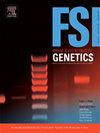TigerBase:DNA 登记系统,加强对圈养老虎设施的执法和合规性检测
IF 3.2
2区 医学
Q2 GENETICS & HEREDITY
引用次数: 0
摘要
老虎(Panthera tigris)及其衍生物(如虎骨、虎牙和虎皮)的非法贸易是该物种长期生存的主要威胁。随着野生虎数量的减少,现在很大一部分被贩卖的老虎产品来自亚洲各地的人工饲养设施。此外,野生虎被偷猎并洗劫到人工饲养设施中,然后被谎称为人工饲养。建立DNA登记系统被认为是监督圈养设施合规性、支持老虎贸易调查和改善起诉结果的重要工具。在这里,我们介绍一个针对圈养老虎的标准化野生动物法医 DNA 分析系统,名为 TigerBase。TigerBase 是在四个拥有圈养老虎设施的东南亚国家开发的:这四个国家是马来西亚、越南、泰国和老挝人民民主共和国。TigerBase DNA 图谱数据基于 60 个单核苷酸多态性(SNP)标记,使用两种不同的 TaqMan® 方法进行基因分型:OpenArray® 芯片(可在单个芯片中对 48 个样本的 60 个 SNP 进行基因分型)和单倍 TaqMan® 检测(可在每个反应中对一个样本的一个 SNP 进行基因分型)。在这 60 个 SNP 中,53 个是常染色体核标记,适用于个体化和亲子鉴定应用;2 个是性连锁标记,适用于性别鉴定;5 个是 mtDNA 标记,适用于母体亚种鉴定。我们进行了一系列验证实验,研究这些 SNP 基因分型平台的可靠性和局限性。我们发现,OpenArray® 芯片平台具有更高的通量,更适合生成参考数据;而单体 TaqMan® 检测具有更高的灵敏度和通量灵活性,更适合对质量较低的个案样本进行基因分型。只有 19 个常染色体核标记物通过了单倍 TaqMan® 检测的验证,这通常为个体化分析提供了足够的能力(同胞间的同一性概率为 6.9 ×10-4),但对于特定的亲子关系问题,例如在父母一方基因型缺失时确定后代的亲子关系,可能缺乏足够的能力。此外,我们还开发了支持标准化 SNP 调用的管道,并通过使用分析工作流和合成阳性对照来降低基因分型错误的几率。我们希望 TigerBase 的实施能加强老虎贩运案件的执法力度,并鼓励圈养老虎设施遵守法规,共同为打击非法老虎贸易做出贡献。本文章由计算机程序翻译,如有差异,请以英文原文为准。
TigerBase: A DNA registration system to enhance enforcement and compliance testing of captive tiger facilities
The illegal trade in tigers (Panthera tigris) and their derivatives, such as bones, teeth and pelts, is a major threat to the species’ long-term persistence. As wild tiger populations have dwindled, a large proportion of trafficked tiger products now derive from captive breeding facilities found throughout Asia. Moreover, wild tigers have been poached and laundered into captive facilities, then falsely designated as captive-bred. The establishment of a DNA registration system is recognized as a key tool to monitor compliance of captive facilities, support tiger trade investigations and improve prosecution outcomes. Here, we present a standardised wildlife forensic DNA profiling system for captive tigers called TigerBase. TigerBase has been developed in four South-East Asia countries with captive tiger facilities: Malaysia, Vietnam, Thailand and Lao PDR. TigerBase DNA profile data is based on 60 single nucleotide polymorphism (SNP) markers, genotyped using two different TaqMan®-based approaches: OpenArray® chip (capable of genotyping 60 SNPs for 48 samples in a single chip), and singleplex TaqMan® assays (capable of genotyping one SNP for one sample per reaction). Of the 60 SNPs, 53 are autosomal nuclear markers, suitable for individualisation and parentage applications, two are sex-linked markers, suitable for sexing, and five are mtDNA markers, suitable for maternal subspecies identification. We conducted a series of validation experiments to investigate the reliability and limitations of these SNP genotyping platforms. We found that the OpenArray® chip platform is more appropriate for generating reference data given its greater throughput, while the singleplex TaqMan® assays are more appropriate for genotyping lower quality casework samples, given their higher sensitivity and throughput flexibility. Only 19 autosomal nuclear markers were validated as singleplex TaqMan® assays, which generally provides ample power for individualisation analysis (probability of identity among siblings was <6.9 ×10−4), but may lack power for specific parentage questions, such as determining parentage of an offspring when one of the parent’s genotypes is missing. Further, we have developed pipelines to support standardised SNP calling and decrease the chance of genotyping errors through the use of analytical workflows and synthetic positive controls. We expect the implementation of TigerBase will enhance enforcement of tiger trafficking cases and encourage compliance among captive tiger facilities, together contributing to combatting the illegal tiger trade.
求助全文
通过发布文献求助,成功后即可免费获取论文全文。
去求助
来源期刊
CiteScore
7.50
自引率
32.30%
发文量
132
审稿时长
11.3 weeks
期刊介绍:
Forensic Science International: Genetics is the premier journal in the field of Forensic Genetics. This branch of Forensic Science can be defined as the application of genetics to human and non-human material (in the sense of a science with the purpose of studying inherited characteristics for the analysis of inter- and intra-specific variations in populations) for the resolution of legal conflicts.
The scope of the journal includes:
Forensic applications of human polymorphism.
Testing of paternity and other family relationships, immigration cases, typing of biological stains and tissues from criminal casework, identification of human remains by DNA testing methodologies.
Description of human polymorphisms of forensic interest, with special interest in DNA polymorphisms.
Autosomal DNA polymorphisms, mini- and microsatellites (or short tandem repeats, STRs), single nucleotide polymorphisms (SNPs), X and Y chromosome polymorphisms, mtDNA polymorphisms, and any other type of DNA variation with potential forensic applications.
Non-human DNA polymorphisms for crime scene investigation.
Population genetics of human polymorphisms of forensic interest.
Population data, especially from DNA polymorphisms of interest for the solution of forensic problems.
DNA typing methodologies and strategies.
Biostatistical methods in forensic genetics.
Evaluation of DNA evidence in forensic problems (such as paternity or immigration cases, criminal casework, identification), classical and new statistical approaches.
Standards in forensic genetics.
Recommendations of regulatory bodies concerning methods, markers, interpretation or strategies or proposals for procedural or technical standards.
Quality control.
Quality control and quality assurance strategies, proficiency testing for DNA typing methodologies.
Criminal DNA databases.
Technical, legal and statistical issues.
General ethical and legal issues related to forensic genetics.

 求助内容:
求助内容: 应助结果提醒方式:
应助结果提醒方式:


